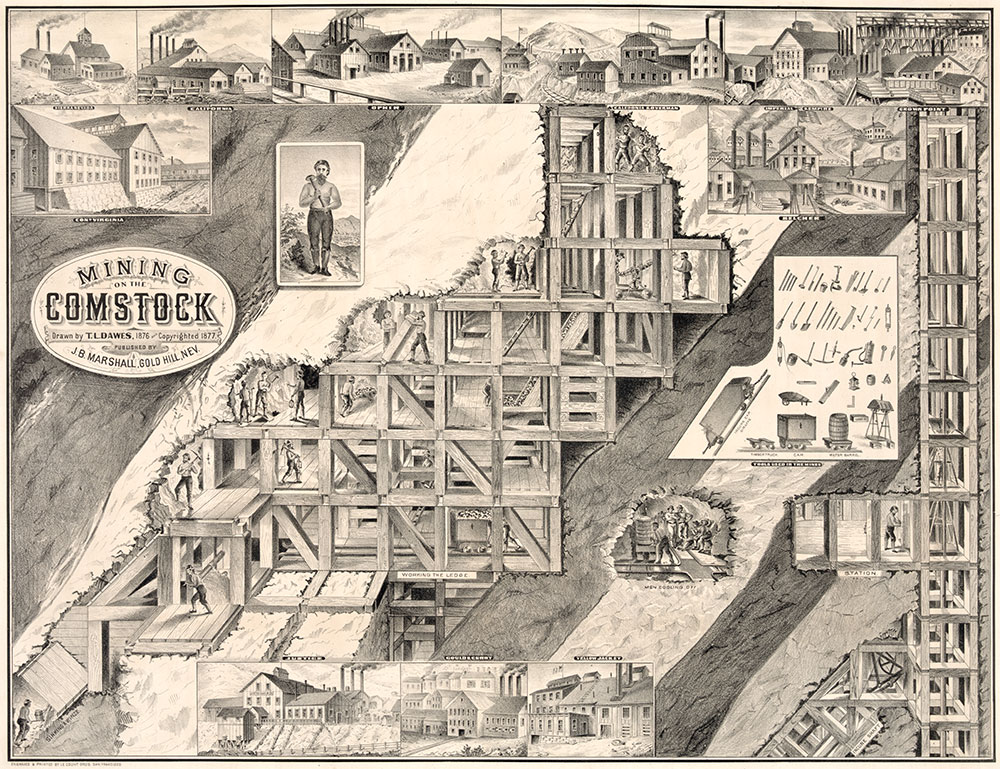Mine Mechanics
January – February 2019
Technology developed in the early days of Nevada mining required innovation, experimentation, and a whole lot of determination.
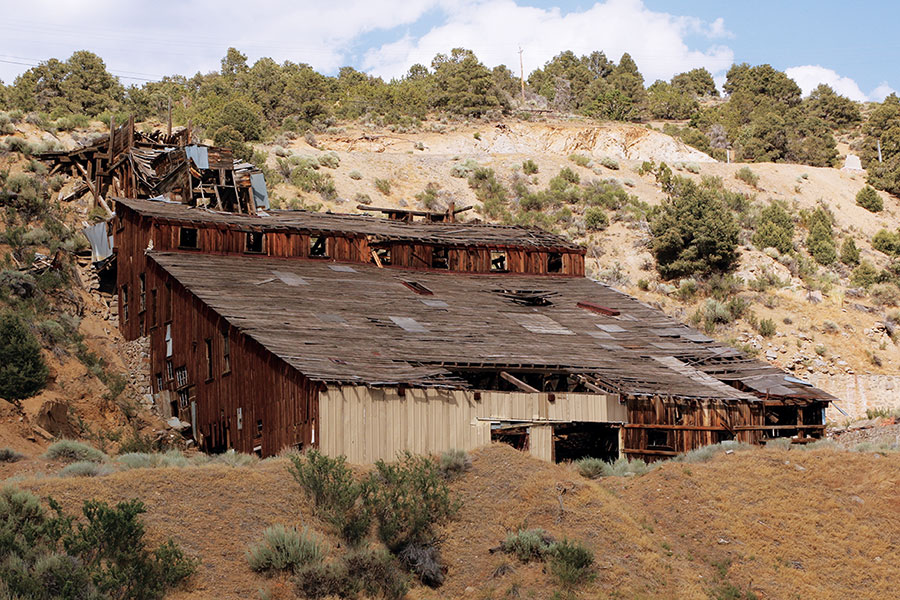
BY ERIC CACHINERO
In July 1849, frontiersman and prospector Abner Levi Blackburn—armed only with a bread pan and butcher knife—went sniffing for gold. Blackburn was guiding a Mormon pack train to the California gold fields, when they stopped to camp at Gold Cañon (the area that would become Dayton). His memoirs recount what would become a monumentally significant discovery:
“I took a bread pan and butcher knife and went out to the raveins [sic] to prospect and found gold in small quantities in three places. Went to a larger raveine whear [sic] the water run down over the bedrock a little on the side of the gulch. Dug down in the slate and found a fair prospect and kept paning [sic] for an hour or more. Went back to camp and all hands grabbed pans, knives, and kettles and started out. We scratched, scraped, and paned [sic] until nearly sundown, earning $10.”
Abner’s find is credited as the first documented discovery of gold in Nevada, meaning that the first mining technology in the state was a simple pan and knife. But those modest tools wouldn’t remain the standard for long. Mining technology would change drastically during the next 100 years, often at a rate of speed that would render revolutionary technology obsolete shortly after its debut.
HAND, PAN, ROCKER, SLUICE, & WASH
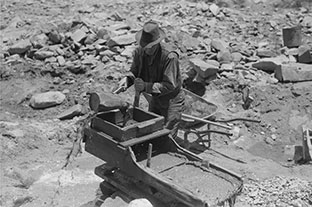
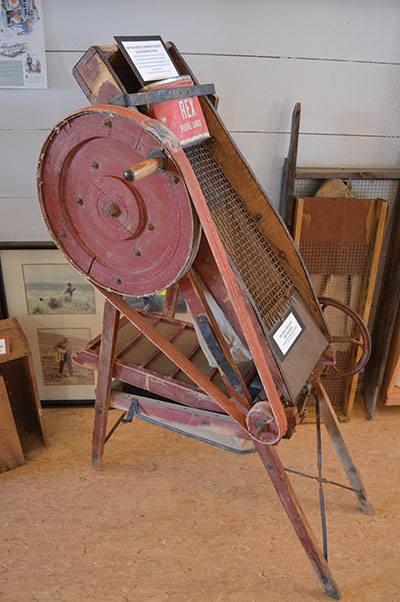
Perhaps the most iconic and recognizable of all mining technology is the gold pan. They have been around since the days of ancient Rome, and as Abner demonstrated, just about anything could be converted into a pan. Prospectors often used steel pans, but didn’t hesitate to use whatever else they had laying around, be it bread pans or pie tins. They sometimes even fashioned them out of wood.
The pan was and still is the cheapest and simplest method of gold extraction and it works by using gravity to the favor of the prospector. Once a prospector found a promising placer (surface) deposit, he would load the (hopefully) gold-bearing dirt into a pan, mix the dirt with water (in areas where water was available), and gently agitate the mixture by shaking the pan back and forth, before intentionally spilling off the top layers of useless dirt. The motion causes the gold—which is 19 times heavier than water and around six times heavier than most other streambed materials—to migrate to the bottom of the pan, while the lighter rocks rest on top before being discarded. The process is repeated until the prospector is left with a highly concentrated pan that usually consists of heavy black magnetite sand and gold.
But gold pans used alone were slow. Miners would often use a rocker box or sluice to concentrate gold on a larger scale after they used a pan to find a suitable prospect area. A rocker box consisted of a high-sided wooden box, with a screen on the top and open on one end, that was placed on rockers (like those found on a rocking chair). Material was loaded into the top with water, then rocked side to side to filter out larger stones and waste material. Gold and other heavy particles would exit through the open hole in the box, and were trapped in carpet (called miner’s moss). The heavily concentrated material could then be panned to extract the gold.
Sluices worked in a similar way, using gravity and water to trap gold. Sluices consist of a wooden frame and a series of drop-offs (think of an extremely narrow hallway consisting of spaced-out declivous stairs). Water is steadily fed into the mouth of the sluice, before running down the series of stairs. Material is fed at the top of the stairs, where it begins to wash down. Lighter waste material is simply washed down the stairs and onto the ground, whereas the heavy gold is trapped behind each stair (riffle) because of the eddy (swirling, reverse circular current) and lower water speed formed behind each one. Sluice boxes are easy to use; however, they’re only about 40-percent efficient and need a constant water supply.
Another method common in early Nevada placer mining was dry washing. Dry washing involved placing material on a riffle board, then using a bellow to blow air over the board. Gold would become caught in the riffles, while lighter materials would be blown off onto the ground. For being such a cheap method, it was quite effective, though more labor intensive than sluicing.
STAMP MILLS
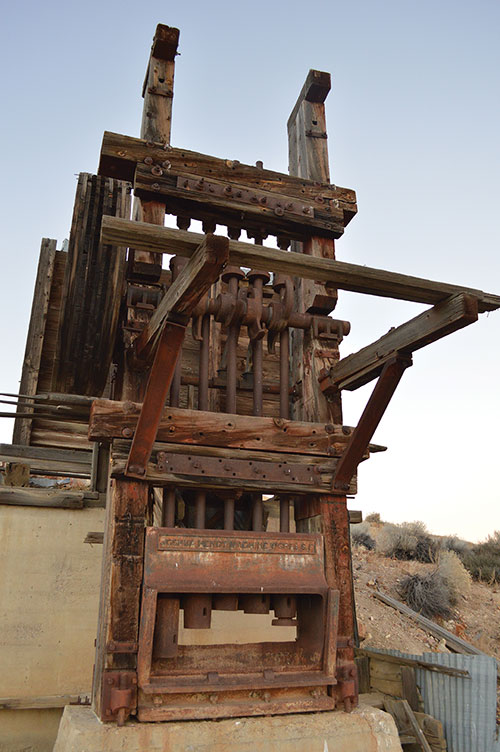
The aforementioned methods were common in early Nevada mining and small-scale operations, but once production ramped up, so did the technology to process it. Unlike placer mining that usually involves finding loose gold on the surface, lode mining involved digging deep for rich veins that were often tightly interwoven and bonded with hard rocks. This created a problem that was quickly solved by the introduction of heavy machinery into the mining process. What was the best way to break up tons and tons of hard rocks? Smash (stamp) the ever-living daylights out of them with giant reciprocating metal stamps, of course.
Queue the stamp mill’s introduction into the Wild West. The first stamp mills began popping up in the eastern states in the early 19th century, and would make their way west, becoming a common method of ore processing well into the 20th century. The stamp mill was widely used in large gold and silver mining camps and remote claims alike, because of its reputation as an effective and relatively portable device. In fact, early advertisements for the machines boasted that all of the necessary parts could be hauled in by mule and assembled at the camps using simple hand tools.
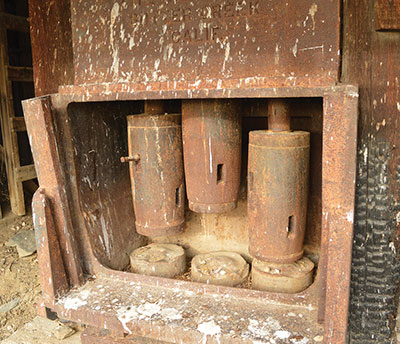
A stamp mill worked using gravity to pulverize rock. The mill consisted of a wooden frame that held a certain number of heavy steel or cast-iron stamps in a vertical position. Ore was fed into the machine via an ore chute. The stamps were raised up and allowed to drop using rotating cams on a horizontal rotating shaft, much like modern car engines use today. A belt—turned using either water, steam, electricity, or internal combustion engine—was used to rotate a large wooden wheel, which turned the cam shaft, raising and dropping the stamps onto the ore, crushing it into finer pieces that could be more easily processed. The process was fast and incredibly noisy.
Stamp mills were often referred to by the number of stamps they had. Many small, remote operations had stamp mills with only three stamps, while some were much larger. Berlin has a remarkably intact 30-stamp mill, while the ghost town of Blair once boasted an impressive 100-stamp mill that in 1907 was the largest such facility in the state.
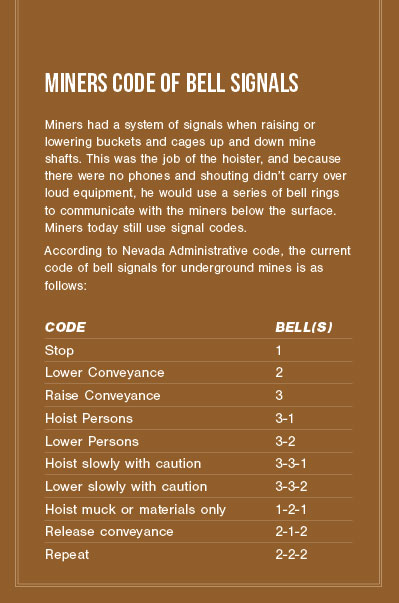 MERCURY, CHLORINE, & SAGEBRUSH TEA
MERCURY, CHLORINE, & SAGEBRUSH TEA
The discovery of The Comstock Lode in 1859 and subsequent boom would forever change the way people mined in Nevada, necessitating new technologies and methods of metal extraction. Unlike gold, which appears in flake and nugget form, the silver of The Comstock Lode ranged from a “bluish putty” to bluish-gray quartz, looking so foreign that even the preliminary prospectors didn’t immediately realize that it was silver.
While panning and sluicing can concentrate gold flakes, how did a prospector concentrate microscopic silver? By heating and evaporating mercury, more commonly referred to in those days as quicksilver. The 1890 newspaper “Alta California” estimated that there were more than 20.5 million pounds of mercury used on The Comstock alone, extracting 8 million ounces of gold and 192 million ounces of silver.
We now know that the solution to this problem wasn’t the safest or most eco-friendly (much of that mercury ended up in the environment around Virginia City). So much mercury was used, in fact, that 15 million pounds of it alone ended up being spilled into the Carson River drainage, according to the Nevada Bureau of Mines and Geology. This spillage resulted in mercury levels 26 times higher than federal standard by 1992 numbers.
Creating gold and silver amalgam (alloy of mercury and another metal) involved mixing the pulverized ore from stamp mills with water, mercury, and salt in heated tubs. The mercury would attract and hold onto particles of silver and gold before it was isolated from waste rocks, heated, and evaporated, leaving only pure silver and gold behind.
There were myriad similar methods and variations used for gold and silver extraction during this time, including the use of chlorine (Ophir Mill in Washoe Valley was known for using this process). In the early days, mill men processing the ore resorted to sometimes almost superstitious experimentation, tossing often-bizarre additives into the mix, such as cedar bark, sagebrush tea, and common trash, hoping to unveil a secret process to isolate the valuable metals.
CYANIDE
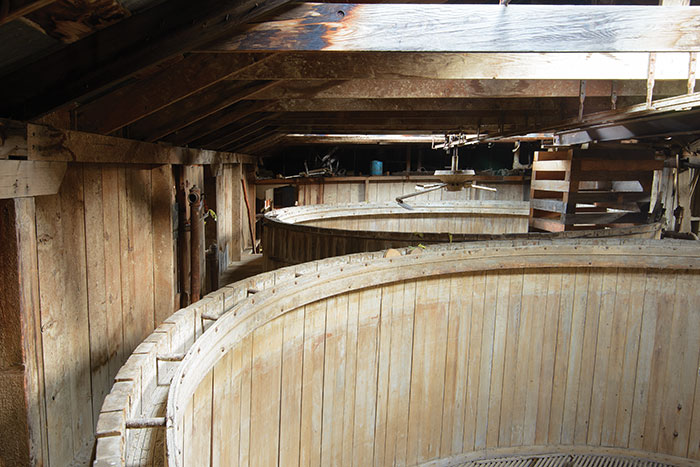
It wasn’t long, though, until another method of gold and silver extraction would render mercury amalgamation obsolete. Developed in the late 1880s, the MacArthur-Forrest cyanide process exposed Comstock ore to cyanide, converting the metals to a water-soluble mixture. The method was simpler and retained more precious metals than the mercury process.
Cyanide mills were employed heavily on The Comstock toward the end of the 19th century. In these mills, crushed ore was suspended in a cyanide solution in large tanks or vats. The solution leached the gold from the ore, allowing miners to efficiently and effectively pull metals from large amounts of material in a relatively quick manner.
Though the methods of application have changed, mixing gold with a cyanide solution is still the most commonly used leaching process to this day, and is employed on an enormous scale at modern gold and silver mines in Nevada.
SCALDING WATER, AIR, DYNAMITE, & DRILLS
Once all of the surface ore was scooped up on The Comstock, miners began to dig, and with that action again came a host of new challenges. Excavating solid earth and rock isn’t easy. In fact, it’s extremely laborious. It required delicate planning, support systems, hoisting mechanisms, proper ventilation, and drainage. Another challenge in The Comstock mines was the extreme temperatures. At several thousand feet below the surface, air temperatures climbed sometimes to more than 120 degrees, while scalding water—in the 150-170 degree range—penetrated the mines and could boil a man to death instantly if he was unlucky enough to come in contact.
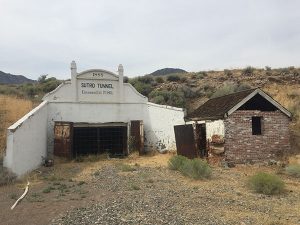
To take care of the hot air problem, vents were dug and ice-cooled air was pumped into the mines, allowing miners to work for more than several minutes at a time. To take care of the water problem, bucket bailers were brought in to pump the water out, before being replaced by superior hydraulic- and steam-powered pumps. More ingenious methods to remove the water from The Comstock mines were also tried. Engineer and philanthropist Adolf Sutro drilled an approximately 6-mile-long horizontal tunnel from Dayton to underneath The Comstock mines to drain the water from the bottom. The plan failed, however, because by the time Sutro’s tunnel reached The Comstock Mines, they had already dug deeper than his tunnel.
In early Comstock mining, simple hand drills and black powder were used to simultaneously dig deeper and separate valuable ore from the surrounding rock. Miners would drill holes into the rocks by hand using a drill bit and a hammer, pack the hole full of explosive, light the fuse, and move away before the blast. Later methods employed the much more efficient pneumatic rock drill to create the drill holes. In 1867, Alfred Nobel (creator of the Nobel Prizes) invented and patented dynamite, which proved to be a much more effective blasting agent than black powder and quickly became the standard explosive for mining.
HEAD FRAMES, CAGES, & ORE BUCKETS
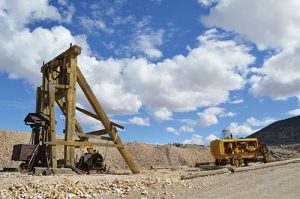
Once miners had blasted tons of ore into smaller pieces, they needed a way to remove it from the mine’s vertical shafts. Miners would load (muck) ore into large metal buckets that also acted as a way to transport both equipment and miners. Larger mines sometime used mine cages, that could hold more weight and resources.
Head frames were used for both delivering men and heavy equipment into the jobsites, as well as hauling rocks out. Head frames were often tall, wooden structural frames at the top of mineshafts that used a cable system to lower and raise weight. The mechanical hoist—housed appropriately in the hoist house—rotated to pull or release a cable, which was wrapped around a wheel at the top of the head frame. The cable was attached at the other end to an ore bucket or mine cage, which held equipment being lowered and raised in the shaft.
Early Comstock mines used hemp ropes to hoist, which became deadly as the mines got deeper. Often, hemp ropes would break when loaded with excessive weight, sending miners plummeting to their deaths at the bottom of deep mineshafts. Later, iron chains were used in place of hemp rope, followed by twisted wire rope that proved much safer (these wire ropes would also be used on San Francisco’s famous cable cars). In addition, mine cages were equipped with spring-loaded rods and teeth that would dig into the sides of the mine and stop a falling mine cage if a cable snapped.
Some mines had horizontal shafts, in which case removing ore carts was often easier and safer than raising and lowering them in deep mineshafts. Ore carts were filled with material, then either pulled by donkeys or mules, or were simply pushed by
men. The combustion engine would later be used to take the burden off men and animals.
TRIED & TRUE TECH

If a Comstock prospector were to somehow time travel to a modern Nevada gold and silver mine, he would undoubtedly be confused. But in some ways, he may recognize the resemblance modern methods and equipment have to the mining of yesteryear. Mine cages still exist; cyanide leaching still exists; dynamite is still used; and in the case of the hobby prospector, the number one tool used is still a gold pan. Modern mining is built off many of the lessons learned from old mining. But no one really uses bread pans and butcher knives anymore…they’re a bit old fashioned.
Square-Set Timbering
When rock was removed from underground mining, regular mine timbers could not support the caverns left behind, and the mines were in danger of collapse. A German-born engineer named Philip Deidesheimer was tasked with creating a new system specifically for The Comstock mines, and his response was the square-set system. He created a series of interlocking timbers that could be used to create support in almost any shape of cavern.
